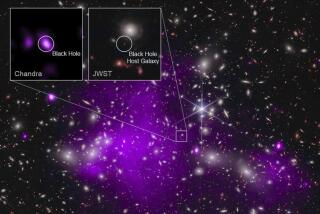Oh Can You See That Black Hole? : Thanks to 10 radiotelescopes, astronomers peer into the heart of darkness
- Share via
7Every once in a while it is comforting to find some news that puts our humble earthly lives in proper perspective.
Our daily worries about crime, freeway closures, floods, the Simpson case and congressional term limits pale in the face of a report that a team of American and Japanese astronomers has peered into the farthest reaches of the universe and found an object, deep within a distant galaxy, that is as massive as 40 million stars the size of our own apparently minor-league sun.
If it indeed exists, this piece of celestial real estate is so dense that it produces a gravitational field powerful enough to prevent even light from escaping.
This, in other words, is what astronomers call a “black hole.” The object is so distant that even if it could emit light, that light would take 21 million years to reach Earth, according to a report given Wednesday to the American Astronomical Society. How many terms of Congress is that? Where will the Dow Jones industrial average stand by then?
What is more, the implication of this research is that there are many more such black holes, even more powerful and more distant.
Theoretical astronomers continue to debate whether the latest report--based on analyses of water molecules surrounding the distant galaxy and serving to amplify the radiation within--does indeed constitute conclusive evidence of black holes or just indicate the presence of a tight cluster of 100 million stars.
It should be comforting to earthlings to know that even astronomers have their battles. Are we talking about 100 million closely spaced stars or a black hole equivalent to 40 million stars? Talk about irreconcilable differences!
What is equally extraordinary is that this discovery comes from having set up an array of 10 radiotelescopes spread over 5,000 miles from Hawaii to the Virgin Islands. Combined, these telescopes offer astronomers such penetrating intergalactic vision that it is like reading a newspaper from 3,000 miles. Would that we had such clarity in our earthly affairs.






